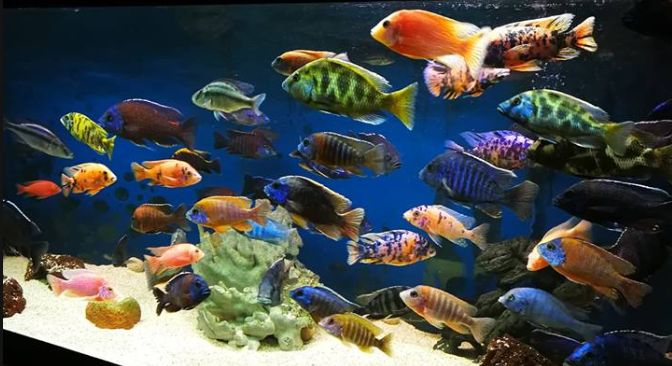
If one is new to fishkeeping, stocking is best looked at not by numbers but rather by water clarity. Slowly add some fish. Then see how it goes. Keep looking down the length of the tank and judging how clear the water is. If the water looks even a little bit cloudy do not add any more fish till the cloudiness clears up. Don’t worry about numbers. Gage the stocking by the health of the tank. How clear is the water? When the water is clear, add more fish. Cloudy water? Wait a while, till the cloudiness or “dullness” clears. Then you can add more fish. Simple!
Stocking and Opinions
The topic of stocking is largely OPINIONS, not experimentally derived scientific facts. Let me repeat that:
.
The Topic of Stocking is Largely OPINIONS
.
So do what YOU want to do with YOUR aquarium. If you want some guidelines which are largely just my opinions, read on.

The Science
Note that there is some science here. And the science says that VERY VERY HEAVY stocking of aquarium tropical fish is quite healthy and does little harm to tropical aquarium fish. The science is based on university research on the zebrafish and can be found in the following article:
13.2. Calculating Stocking Ratio
My Opinions and Recommendations
IN MY OPINION, the following stocking ratios, based on the volume of fish, are perfectly acceptable for a 100 gallon tank:
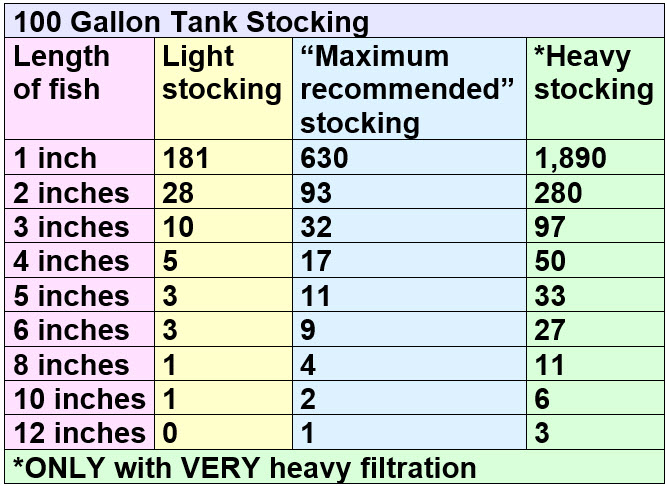
.
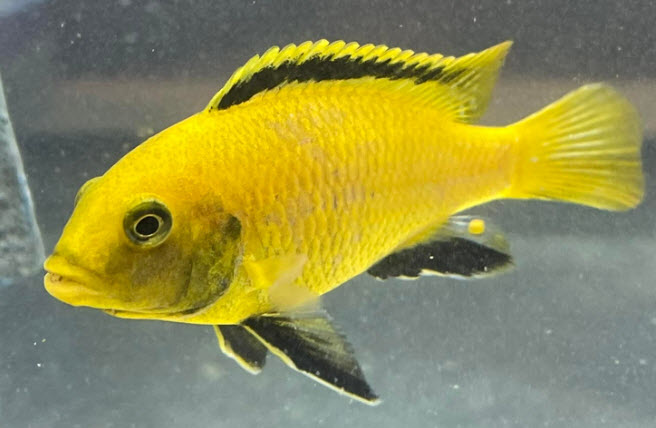
For a 50 gallon tank the stocking numbers are:
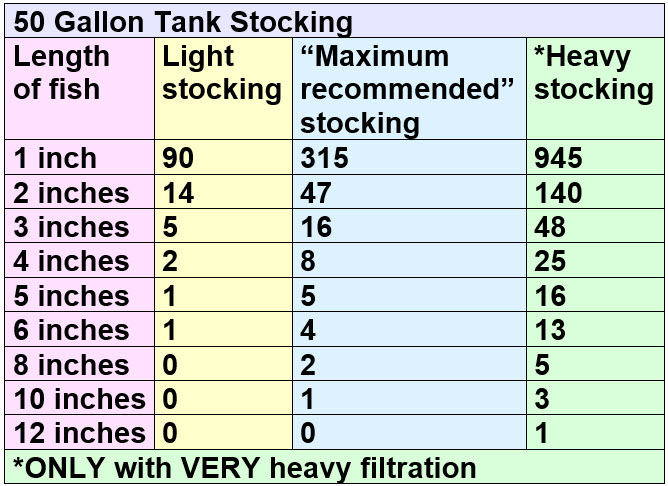
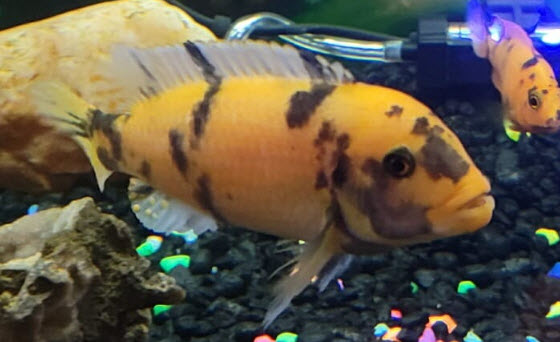
For a 25 gallon the stocking numbers are:


For a ten gallon the numbers are:
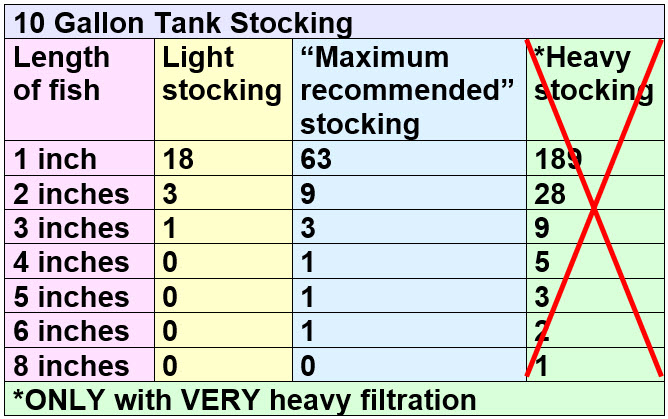
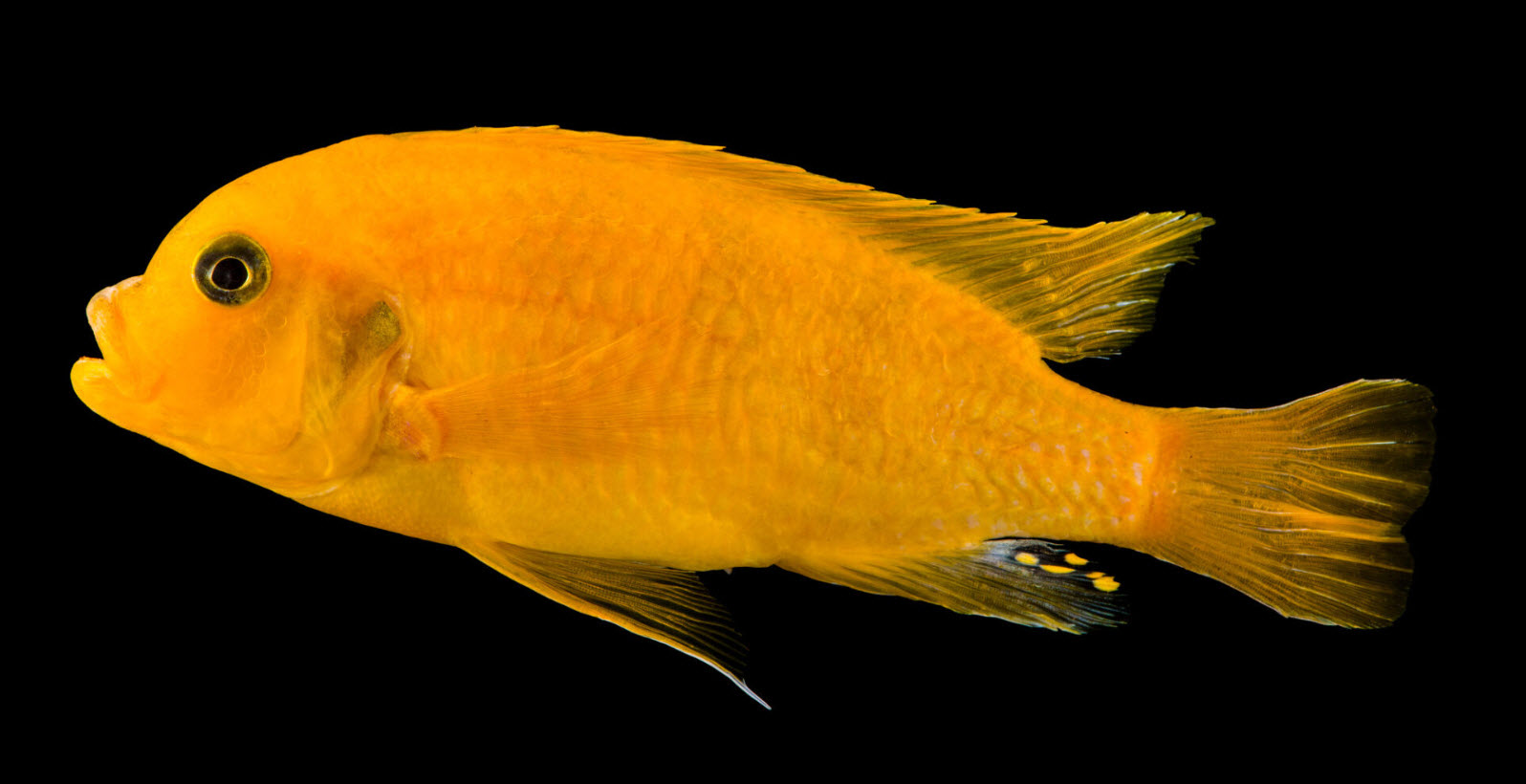
For a five gallon the numbers are:

The heavy stocking columns for the ten and five gallon aquariums have been crossed out for a reason. The filters for small tanks are always very small cartridge or air operated sponge filters. These filters are just totally inadequate to support heavy stocking. So small aquariums should not be heavily stocked. If one puts something like a very small canister filter on a ten gallon, one can think about heavy stocking. But I’ve never seen that done.

To get a good number with mixed sizes just takes some common sense approximating. Start with the largest fish and work your way down in size. Say you have a 50 gallon and want to stock at the maximum recommended level.
Say you want 10 three inch fish. The 10 three inch fish is very roughly about half the quotas for “Maximum recommended”. That leaves 50% which could be 23 two inch fish (50% of 47). But lets say its ten three inch (roughly 50%) and 12 two inch (roughly 25% of 47). Then you would have room for one fourth (25%) of the 315 in one inch fish or about 80 one inch fish. So it is 10 three inch, 12 two inch and 80 one inch fish in a fifty gallon.
That is all very rough. A more thorough analysis involves using the weight of the fish and gets all complicated totally unnecessarily. The easy way to do it is just to add small numbers of fish till the water turns “dull”. Then stop adding till the water becomes crystal clear. Then add more fish. Easy.

Now these numbers, especially the “heavy stocking” numbers, will absolutely send some “fish police” into absolute hysteria and get this site kicked off many Facebook forums. Remember, the heavy stocking levels are only “ MY OPINIONS” (not “rules”) based on WELL FILTERED AQUARIUMS WHICH HAVE LARGE FILTERS WITH GOOD MEDIA THAT HASN’T BEEN FREQUENTLY CLEANED!!!!!
There are ways to determine the amount of media and the amount of filtration needed for a given loading of fish. They can be found in the following link:
8.8. Sizing Filters and Media
In the in depth articles below I give my OPINIONS on the topic and the OPINIONS of others. It is all a rambling set of OPINIONS so unless you want to get really bored, stop right here.
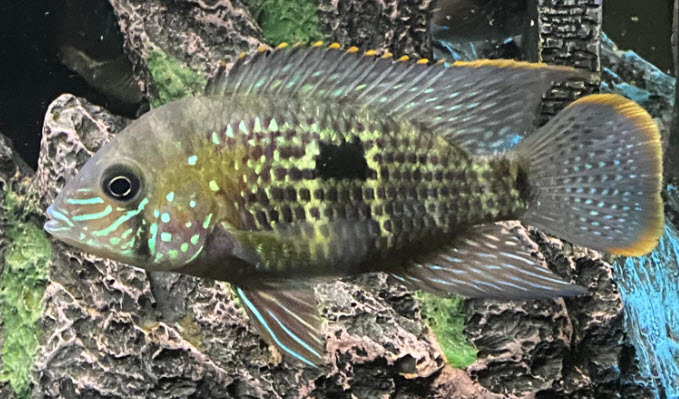
Stocking in Greater Depth
Hopefully the following links can put some common sense into this subject:
13.1. Stocking Opinions
13.2. Calculating Stocking Ratio
13.3. Lifespan of the Fish
And the common or narrow bodied goldfish should be stocked as a five inch fish.
This is delved into in this link:
17.5. Goldfish.

.
Return to Home Page and Main Menu
Aquarium Science Website
The chapters shown below or on the right side in maroon lead to close to 400 articles on all aspects of keeping a freshwater aquarium. These articles have NO links to profit making sites and are thus unbiased in their recommendations, unlike all the for-profit sites you will find with Google. Bookmark and browse!
.

M says
In reply to dave, thanks for taking the time to help me out.
Dave says
In reply to M …. Yes the black ones. Stuff the HOB with as many of those inserts as will fit. And you can replace kuhli’s with Cories.
M says
In reply to dave, do you mean the black ones, if so i already have one in the filter. i also would like to know if i can replace the kuhli loaches with 5 cories to get 8 cories in total and some caridinia shrimp instead as i reand the corys need to be in a large shoal.
Dave says
In reply to M …… Change out your filter floss for foam (Cory at aquarium coop has the inserts) and don’t clean the filter till the flow slows way down. Your stocking should be just fine then.
M says
Hi Dave, right now I have 2 corys and a baby ramshorn snail in a heavily planted 10 gallon with a HOB filter with a lot of filter floss as the filter media. I plan to add another cory, 4 Kuhli loaches and somewhere between 5-6 of either neon tetras or white cloud mountain minnows. Will the tank be able to support this kind of bioload? the tank has been cycled for 6 months now.
Dave says
In reply to Dan …… Yes, they contribute the same as a one half inch fish or one eighth the demand of a one inch fish.
Dan says
do you count the red cherry shrimp as contributors to bioload?
thanks. love the site
Jaume says
In reply to Dave 2024-08-04 at 7:54 pm
I have an Eheim Classic 150, that I am going to fill ONLY with K1 media as suggested by you. I assume that will be good enough filtration.
Thanks.
Dave says
In reply to Jaume You are 100% correct. Six platies it is WITH GOOD FILTRATION.
Jaume says
Hello, and thanks for all the information.
I am a beginner with a +-37l aquarium with two female platys at the moment (only females will go in this tank, to avoid having to care about over-stocking), according to aquariumcoop.com and other sites, platys may grow up to 5-7cm or 1,9 to 2,7 inches. Then, as per your tables, I could have about 6 platys, perhaps? Assuming not all of them will grow up to 2,7 inches.
Apologies for commenting on several pages, thank you for your time in advance.
ben z says
@Phil and @Dave
I have thought about this question before, and one hypothesis I came to is that the 1 inch per gallon rule might actually have something to do with the species of fish popular in whichever country/culture where that rule first arose. The inch/gallon rule is baseless if one takes the tank size to fish weight ratio as the basis for calculating density. However, it actually is a good rule of thumb when dealing with certain fish species that exhibit territorial behaviour.
I like to think about it this way: some fish are like (human) teenagers. If you make 2 or more teenage siblings share 1 bedroom, they WILL squabble sooner or later. The smaller the bedroom, the worse it will be.
So, I would investigate the ethology of the fish species popular in the country/countries where those guides that first mentioned the rule were published. By the way, I’m from Asia, and generally stocking densities are WAAAAY higher than the guidelines promulgated as gospel on the (English-speaking/American-dominated) internet. Of course, in the myths of fishkeeping, the European literature matters a lot too. But my point is, the sociocultural aspect of it all matters.
The cynical view would be that tank manufacturers wanted to sell more tanks.
It could also be that technology was the “culprit”. One inch per gallon might be a sensible guidelines in a time where aeration and filter technology were nothing like today’s.
Just some ideas on how I would approach the question. I have thought of writing a book on the history of fishkeeping before, but I shelved that idea because the volume of archival (and other) work needed isn’t something I see as practical unless some foundation funds it. But I do urge anyone researching the topic to please not publish anything as fact unless one is very confident in their conclusions. The available historical materials on this topic are already muddy enough. Muddying them further would make serious work very tough for future historians.
But, lest anyone get the wrong idea, I hasten to add that that the hypotheses above DO NOT conflict with the fish weight/tank volume paradigm of stocking density. To use the same analogy. If 2 teenage siblings are sharing a bedroom of a given size X, and you hire a contractor to install a partition and turn that bedroom into two, peace returns. (This analogy is valid because fish, unlike teenagers, do not leave their tanks and roam the house.)
Expanding upon this, the metabolic weight to tank volume (or effective filter surface area rule) really should be seen as just one of several possible limiting factors in stocking. Aggression is the obvious alternative that comes to mind. You cannot stock multiple male bettas in one tank based on their metabolic weight.
Another issue with the science behind stocking densities is that the formal scientific research is mostly based on food fish – and aquaculture operations DO NOT do research on fish that people don’t eat. Also, one of the criteria for what makes a “good candidate” for aquaculture is whether the fish can be reared densely. So, there is an inherent bias in the journal literature when it comes to stocking densities.
Finally, even among freshwater food fish, the literature is heavily biased towards the tilapia – the classic model organism. But what if you have food fish that breathe air? The snakehead is one of them. So the limiting factor wrt tilapia (DO levels) might not be the limiting factor for snakeheads. But since the majority of research funding is disbursed in North America, and tilapia sells better in that market, the literature would again be inherently biased.
Just my two cents.
B says
You’re the best! I’ve come across your site multiple times and finally took the time to read the filter media section and applied what you recommended. Two months later and I have no tank issues at all! I know that the only way someone gains as much knowledge on such a breadth of topics is by pure experience — and your expertise has saved my aquarium and kept me in the hobby (and with happy fish). 🐠
Dave says
In reply to anonymous …. No, those are all small bioload fish so you are just fine. My opinion is that that is light stocking.
Anonymous says
Would 3 hillstream loaches, 20 amano shrimp, 8 nerite snails, 10 green neon tetras, 10 Pygmy Corydora, and 12 chili rasboras be too much for an undergravel operated planted 29 gallon?
Thanks
Dave says
In reply to K …… No idea where that came from. Sorry
K says
Hi Dave, I recently discovered your website and have greatly enjoyed browsing it. I have been keeping fish for years and have always longed to find someone producing ad-free content based on research and experience. I have been working on a project covering the topic of aquarium stocking for my own knowledge and hopefully to share with others when it is ready. Your write up here, as well as the research you shared, has been a huge help for my own understanding and finding a starting point with my reading. I have been working on a section all about the inch per gallon rule and why it has been so prominent in the hobby. As a part of this, I have been trying to learn about where that dastardly rule actually came from and have not had much luck. I have seen it in books from the early 1980’s, so I know it has been around for quite a while. Do you have any idea of where it came from, or at least know of an earlier reference to it? Thanks for all of your work.
Dave says
In reply to Phil …. I wouldn’t go beyond the “Maximum Recommended” but that is simply a baseless opinion. So if you want to go higher over the span of several months go ahead and do it.
Phil says
Dave, would you encourage relatively heavy stocking of a 10-gallon with an under gravel filter? Maybe not up to the numbers in your “Heavy Stocking” column, but more than the “Maximum Recommended” column. What do you think?
Thanks!
Phil